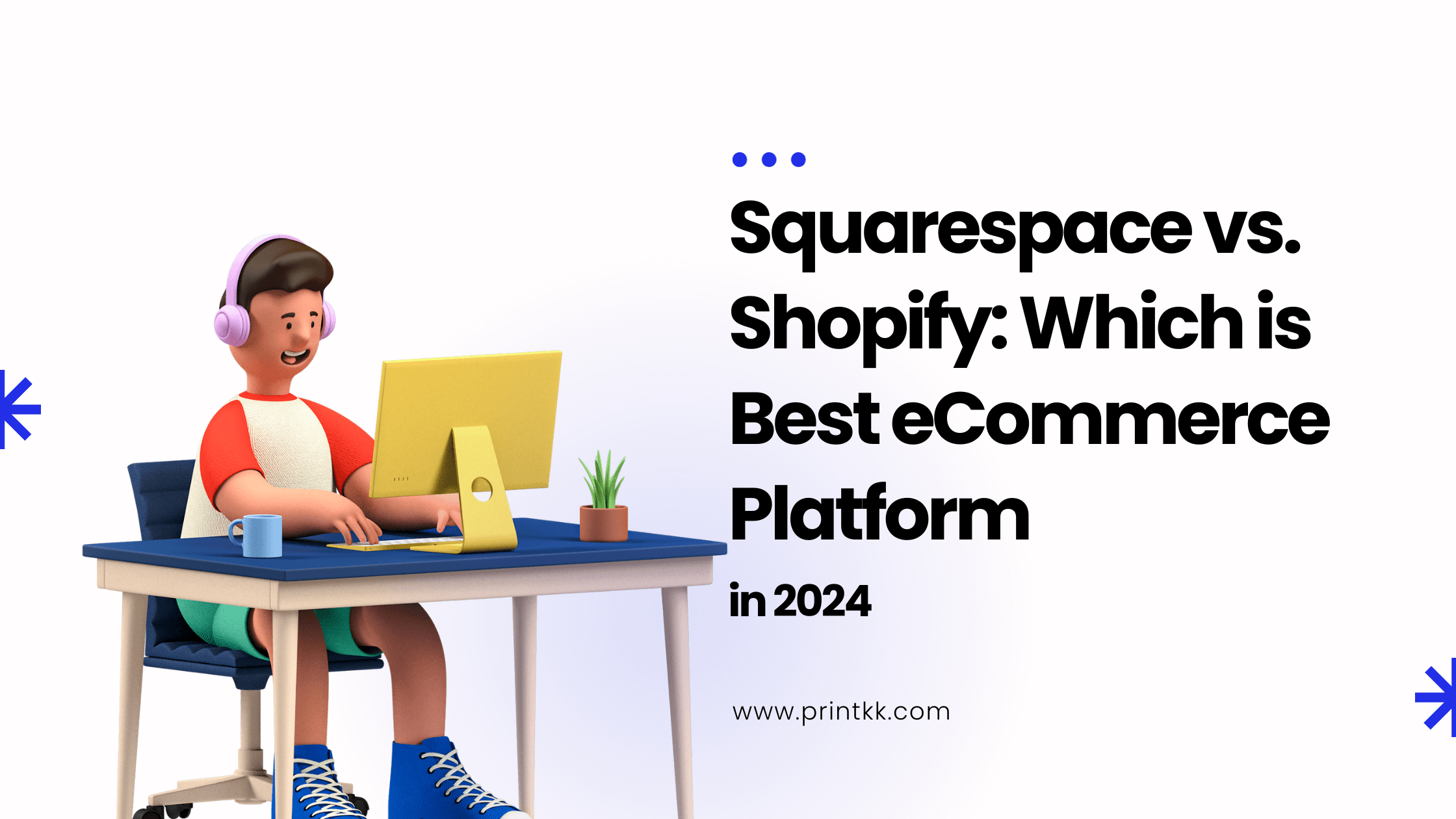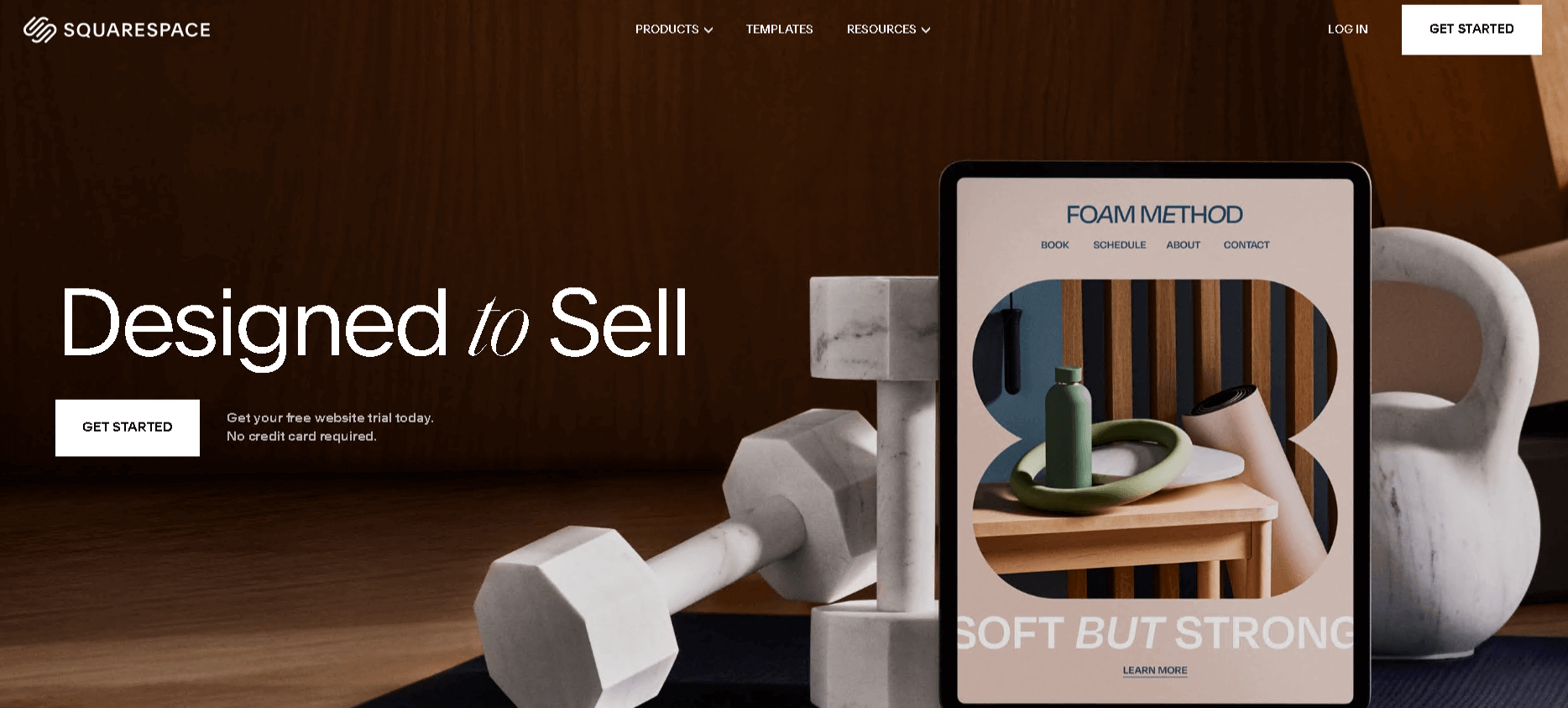
In the dynamic world of online commerce, the decision between Squarespace and Shopify is more crucial than ever. Are you an entrepreneur or small business owner grappling with this choice? Our comprehensive guide dives deep into each platform's offerings, laying out their strengths and weaknesses. Discover which platform aligns perfectly with your business's unique needs, be it for a visually stunning online presence or a robust e-commerce powerhouse. Let's embark on this journey to find the ideal eCommerce solution for you.
What Is Squarespace?

In today's digital era, the choice of the right platform for building an online presence is crucial for entrepreneurs, small business owners, designers, artists, and even large corporations. With a myriad of options, it becomes a daunting task to pinpoint which service aligns perfectly with your unique business needs and aesthetic preferences. This is where Squarespace enters the picture.
Squarespace is more than just a website hosting platform; it's a comprehensive solution that marries design and functionality seamlessly. Known for its visually stunning, designer-grade templates, Squarespace is the go-to for anyone looking to create an impactful online presence. Its intuitive drag-and-drop interface makes it a favorite among non-tech savvy users, while its robust features cater to the needs of growing businesses and established brands alike. Whether you're showcasing a portfolio, launching an e-commerce store, or building a corporate site, Squarespace equips you with the tools to craft a captivating digital space that speaks volumes to your audience.
What Is Shopify?
 In the ever-evolving landscape of e-commerce, selecting the right platform for creating an online store is a pivotal decision for entrepreneurs, small business owners, and dropshippers. Amidst a plethora of choices, one platform stands out for its robustness and user-friendly approach: Shopify.
In the ever-evolving landscape of e-commerce, selecting the right platform for creating an online store is a pivotal decision for entrepreneurs, small business owners, and dropshippers. Amidst a plethora of choices, one platform stands out for its robustness and user-friendly approach: Shopify.
Shopify has revolutionized the e-commerce industry, offering a comprehensive suite of tools that cater to the diverse needs of businesses of all sizes. From aesthetically pleasing and customizable website templates to an integrated payment processing system, Shopify simplifies the online selling process. Its intuitive interface allows even those with minimal technical expertise to create a fully functional online store, while advanced features and analytics cater to the needs of larger corporations and brands looking to expand their online presence.
The platform's versatility extends to various industries and professions. Whether you are a designer eager to showcase and sell your creations, an artist looking to connect with a broader audience, or a corporation aiming to streamline your online sales process, Shopify provides a scalable and efficient solution. It empowers you to build a unique online store that not only reflects your brand's identity but also offers a seamless shopping experience to your customers, ultimately driving growth and success in the digital marketplace.
Pros & Cons of Squarespace vs Shopify
 In the competitive world of e-commerce and website building, two names often come to the forefront: Squarespace and Shopify. Each platform boasts unique features and functionalities catering to a diverse range of users - from entrepreneurs and small business owners to designers, artists, and large corporations. Understanding the strengths and limitations of Squarespace and Shopify is essential for making an informed decision.
In the competitive world of e-commerce and website building, two names often come to the forefront: Squarespace and Shopify. Each platform boasts unique features and functionalities catering to a diverse range of users - from entrepreneurs and small business owners to designers, artists, and large corporations. Understanding the strengths and limitations of Squarespace and Shopify is essential for making an informed decision.
Squarespace Pros
Exceptional Design and Aesthetics
Intuitive User Interface
Strong Focus on SEO
All-in-One Platform
Excellent Customer Support
Squarespace Cons
Limited E-commerce Tools
Fewer Payment Gateways
Limited Third-party App Marketplace
Shopify Pros
Robust E-commerce Capabilities
Extensive App Marketplace
Diverse Payment Gateway Options
Scalability for Growing Businesses
Advanced Sales Features and Analytics
Shopify Cons
Higher Learning Curve
Transaction Fees on Certain Plans
Less Emphasis on Aesthetic Design
Key Differences Between Squarespace and Shopify
When it comes to choosing an e-commerce platform, the decision often boils down to Squarespace and Shopify. Both platforms offer unique features and functionalities that cater to different types of users, from entrepreneurs and small businesses to designers, artists, and large organizations. Understanding the key differences in their pricing plans, features, ease of use, security, and various other aspects is crucial for making an informed choice that aligns with your specific business needs.
| Feature | Squarespace | Shopify |
| Pricing Plans | Offers a range of plans with a focus on affordability. | Provides tiered pricing, catering to businesses of all sizes. |
| Features | Known for stunning design templates and artistic tools. | Robust e-commerce features and advanced sales tools. |
| Ease of Use | User-friendly interface, ideal for beginners. | Steeper learning curve, but offers more advanced functionalities. |
| Security | Reliable security features with SSL certificates. | High-end security with SSL and additional measures for e-commerce. |
| Shipping Options | Basic shipping features suitable for smaller businesses. | Comprehensive shipping solutions for a global reach. |
| Inventory Management | Simplified inventory management ideal for small inventories. | Advanced inventory management suitable for larger operations. |
| Dropshipping | Basic dropshipping capabilities. | Extensive dropshipping support with a wide range of apps. |
| Customizability | High-level design customization, less on e-commerce features. | Extensive customizability, especially in store functionalities. |
| Usability | Excellent for content-based websites and portfolios. | Optimized for e-commerce with a focus on sales efficiency. |
| SEO | Strong SEO tools for content visibility. | Advanced SEO features tailored for e-commerce. |
| Payment | Limited payment gateway options. | Wide range of payment gateways, including Shopify Payments. |
| Integrations and Apps | Limited third-party apps and integrations. | Extensive app store with numerous integrations. |
| Customer Support | High-quality customer support with various channels. | Comprehensive support, including 24/7 options. |
Squarespace vs. Shopify: Which Is Right for Your Business?
In the digital marketplace, choosing the right platform for your business website can be a game-changer. Squarespace and Shopify are two leading contenders, each with its own set of strengths. Understanding these can help entrepreneurs, designers, small business owners, and various other professionals make an informed choice.
To effectively compare the Squarespace and Shopify platforms, I delved into the digital depths and sourced insights from three authoritative YouTube channels: Site Builder Report, Style Factory, and Learn With Shopify. After meticulously watching and digesting their content, I've synthesized the following insights.
Site Builder Report: SQUARESPACE vs SHOPIFY — Which Is Better?
Background:
Shopify's homepage focused on building online stores.
Squarespace's homepage was about building various types of websites, not just for e-commerce.
Ease of Use:
Squarespace offers a visual editor, allowing users to see changes as they edit.
Shopify's editor is not visual; users must save and preview changes separately.
Squarespace's flexible editor is suitable for various page types, while Shopify focuses on standard online store pages.
E-commerce:
Shopify excels in e-commerce, simplifying complex aspects like payment processing, taxes, and shipping.
Shopify Payments is integrated by default, while Squarespace requires setting up with Stripe or another processor.
Shopify automatically handles taxes and integrates with many shipping services, whereas Squarespace has more limited options.
Shopify's App Store offers a wide range of additional e-commerce features, while Squarespace's Extensions are fewer.
Templates:
Both platforms offer beautiful templates, but Squarespace templates are easier to customize.
Shopify has both free and paid themes, plus a marketplace for third-party themes.
Squarespace provides around 110 templates, all created in-house, ensuring quality and compatibility.
Pricing:
Squarespace has four plans; the personal plan is comparable in price to other website builders but doesn't include e-commerce.
Shopify's three main plans all include e-commerce; their basic plan is cheaper than Squarespace's basic commerce plan.
Key Takeaways:
Use Squarespace for small websites or small e-commerce operations (like selling a few items).
Choose Shopify for online stores with regular sales, as it streamlines the complexities of running an e-commerce business.
Style Factory: Shopify vs Squarespace (2023) — Which is Better? / Key Pros and Cons
Reasons to Use Shopify Over Squarespace:
More Flexible E-commerce Tools
Better for Dropshipping
Superior for Point of Sale (POS)
Stronger International Selling Features
More Payment Gateways
Abandoned Cart Saving on All Plans
Better Automatic Tax Calculation
More Integrations Available
More Comprehensive Customer Support
Reasons to Use Squarespace Over Shopify:
More Free and Stunning Templates
Easier to Use
Better Website Building Features
Easier to Sell Online Courses
Better Handling of Product Images
Learn With Shopify: Shopify vs Squarespace: Which is the Best eCommerce Platform?
Introduction:
Shopify and Squarespace are both website builders.
Shopify is designed for e-commerce, while Squarespace is for content like portfolios and blogs.
Pricing:
Shopify has three main plans, with the basic one starting at $29/month, offering e-commerce integrations, 24/7 support, and unlimited products.
Squarespace starts at $16/month for content-focused sites. For e-commerce, the plan is $35/month, also with 24/7 support and unlimited products.
Templates & Ease of Use:
Squarespace offers 110 free templates, mainly for content presentation, with a few dedicated to online stores.
Shopify provides over 80 free and premium templates tailored for e-commerce.
Both platforms offer responsive designs and customization options, but Shopify templates are optimized for conversions.
Dropshipping & Print on Demand:
Shopify is preferred for dropshipping and print on demand, with a wide range of apps like Oberlo and Printful.
Squarespace has fewer options and is less suited for these business models.
Transaction Fees:
Squarespace charges 3% transaction fees on the Business plan, plus credit card processing fees.
Shopify charges 2% to 3.5% transaction fees, varying by payment method, and generally no fees on POS transactions.
Shopify is slightly cheaper regarding transaction fees.
Third-Party Integrations & Apps:
Squarespace has about 28 apps in its extensions store.
Shopify boasts over 6,000 apps, offering a vast range of functionalities.
Added Bonuses:
Squarespace offers a free domain with an annual plan and a free Google Workspace on certain plans.
Verdict:
Shopify is the best choice for a strong e-commerce platform with features like multi-currency support, payment gateways, POS, and professional reporting.
Squarespace is ideal for content-focused websites without the need for extensive e-commerce functionalities.
Michelle recommends trying both platforms to see which one fits your needs better.
Viewer Questions:
You can switch from a free to a paid template on Shopify at any time.
It's possible to use both print on demand and dropshipping in one Shopify store by downloading the respective apps.
Making the Choice
In deciding between Squarespace and Shopify, consider your primary focus. If your business thrives on visually-driven content and brand storytelling, Squarespace could be your ideal choice. However, if your priority is a powerful e-commerce setup with extensive functionality, Shopify stands out. And for those seeking a blend, combining the two could be a uniquely effective strategy.
Summary
Squarespace shines for those valuing design and simplicity. With its elegant templates and intuitive interface, it's perfect for brands focused on aesthetics and content. However, its e-commerce features, though improving, are not as comprehensive as Shopify's. Hence, it's ideal for visually-driven sites rather than complex online stores.
In contrast, Shopify excels in robust e-commerce functionalities. It caters to businesses of all sizes, offering advanced sales tools and scalability. If your priority is a powerful online store with extensive selling capabilities, Shopify stands out as the superior choice. For some, combining Squarespace's design strengths and Shopify's e-commerce prowess could offer a balanced solution.
FAQs
Is Shopify better than Squarespace?
Choosing between Shopify and Squarespace depends on your priorities. Shopify is the go-to for comprehensive e-commerce tools and scalability, ideal for online retail growth. Squarespace shines with its design quality and ease of use, suited for visually-driven sites with rich content. Opt for Squarespace for design appeal or Shopify for e-commerce prowess.
Is Squarespace good for ecommerce?
Squarespace is suitable for ecommerce, particularly for those prioritizing design and ease of use. It offers elegant templates and intuitive tools, enough for small businesses to build attractive online stores. Despite fewer ecommerce features than Shopify, it covers essentials like payment processing, inventory tracking, and SEO. It's best for those seeking a mix of aesthetics and online sales functionality.
Does Squarespace integrate with Shopify?
Squarespace and Shopify can be integrated by embedding Shopify 'Buy Buttons' into a Squarespace site, merging Squarespace's design with Shopify's e-commerce strength. While this provides a blend of aesthetics and functionality, it may require technical skills and could result in a less seamless experience than using each platform on its own.
Which e-commerce platform is best?
Choosing the "best" e-commerce platform depends on your business priorities. Squarespace shines with its beautiful designs and user-friendly interface, ideal for brand-focused storytellers. Shopify stands out for its robust e-commerce capabilities, suited for those concentrating on sales and expansion. Entrepreneurs should weigh their need for visual appeal against e-commerce functionality to select the platform that best fits their strategy.










 Global Shipping
Global Shipping




























